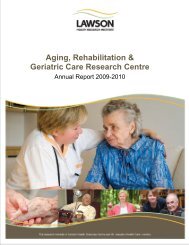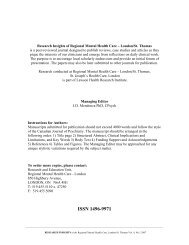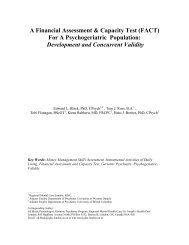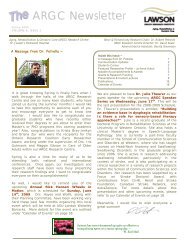REFORMS TO ONTARIO'S MENTAL HEALTH ACT: Lessons from ...
REFORMS TO ONTARIO'S MENTAL HEALTH ACT: Lessons from ...
REFORMS TO ONTARIO'S MENTAL HEALTH ACT: Lessons from ...
- No tags were found...
You also want an ePaper? Increase the reach of your titles
YUMPU automatically turns print PDFs into web optimized ePapers that Google loves.
3incident raised questions about both what happened to Arenburg following the killing of Smith and theefficacy of the law named in his memory. Had Arenburg been released <strong>from</strong> the criminal justice systemwithout treatment and adequate supervision? Given that assaulting an armed American customs officer isunlikely to end well for the assailant, who was looking out for Arenburg’s interests? Finally, would thelegislation named after Smith have prevented Arenburg <strong>from</strong> killing Smith?In an attempt to answer these questions, we reviewed Arenburg’s clinical history. In previous work, wedeveloped a method for constructing a clinical profile of individuals with mental illness using informationavailable in the public domain. 6 We anticipated that this method could be used in Arenburg’s case, as hiscase had generated considerable media coverage, and we knew that additional public documents would beavailable <strong>from</strong> the Ontario Review Board. 7The confidentiality obligations of clinicians limit their ability to educate the public, policy makers and thelegal profession about mental illness and its treatment. Given the volume of public information, theArenburg case offers a rare opportunity to provide a detailed description of an individual’s psychiatricillness, how it caused him to act violently and his response to treatment. Our research has also allowed usto examine previous media reports that Arenburg may not have met the criteria for a C<strong>TO</strong> under thelegislation that was named after his victim. 8 On a broader level, Arenburg’s story underscores theimportance of ensuring that mental health reforms actually address the ongoing needs of people withserious mental illness.METHODInformation was drawn <strong>from</strong> several different sources. The court records for Arenburg’s murder trial wereobtained <strong>from</strong> CanLii and LexisNexis. American court records were accessed through the Pacer CaseThe Ottawa Citizen, May 22, 2008, http://www.canada.com/ottawacitizen/news/story.html?id=76d2a4a0-e323-4901-a326-fe43a286ae946 Robert Solomon et al, Treatment Delayed - Liberty Denied, 87:3 Can. Bar. Rev. at 690-91 (2008).7 The Ontario Review Board, like the other provincial review boards, is a quasi-judicial agency that was created in 1992 underthe Criminal Code, R.S.C. 1985, c. C-46 § 672.38 (Can.). Review boards are responsible for supervising suspects who have beenfound “unfit to stand trial” and individuals who have been found “not criminally responsible on account of mental disorder”(NCR) (Id. § 672.38(1)). The Criminal Code requires the review boards to assess each individual at least once a year and theseassessments are generally in the public domain (Id. § 672.81(1)).The Ontario Review Board must be distinguished <strong>from</strong> the Ontario Civil “Review Board” that adjudicated disputes about civilcommitment, treatment and capacity issues under the Mental Health Act. This Ontario Civil Review Board was replaced by the“Consent and Capacity Review Board” in April 1995, which in turn was replaced by the “Consent and Capacity Board” in March,1996. See respectively, Consent and Capacity Statute Law Amendment Act, 1992, S.O. 1992, c. 32, § 20(1) (Can.); and HealthCare Consent Act, 1996, S.O. 1996, Schedule A, § 70(1) (Can.).8 Scott Simmie, When following an order would be wrong, The Toronto Star, October 4, 1998; and Anita Szigeti, OntarioCommunity Treatment Orders: How Did We Get There and Where Do We Go Now? An Advocate’s Perspective, 21 Health L.Can. 66 (2001).RESEARCH INSIGHTS of the Regional Mental Health Care London and St. Thomas; Vol. 9, No.3, 2012














